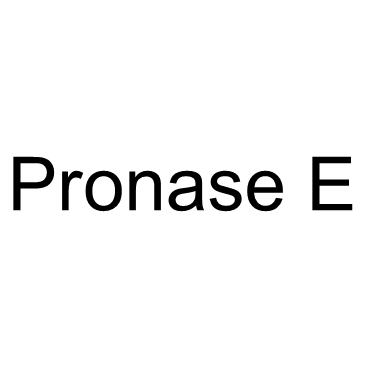Pronase E

Pronase E structure
|
Common Name | Pronase E | ||
|---|---|---|---|---|
| CAS Number | 9036-06-0 | Molecular Weight | 420.539 | |
| Density | 1.1±0.1 g/cm3 | Boiling Point | 493.1±40.0 °C at 760 mmHg | |
| Molecular Formula | C24H36O6 | Melting Point | N/A | |
| MSDS | Chinese USA | Flash Point | 209.6±27.4 °C | |
| Symbol |


GHS07, GHS08 |
Signal Word | Danger | |
Use of Pronase EPronase E is a mixture of proteolytic enzymes that is obtained from Streptomyces griseus and could digest protein into individual amino acids. |
| Name | 5-[(3Z)-4,8-Dimethyl-3,7-nonadien-1-yl]octahydro-2H-1,7-dioxacyclopenta[cd]indene-2,6-diyl diacetate |
|---|---|
| Synonym | More Synonyms |
| Description | Pronase E is a mixture of proteolytic enzymes that is obtained from Streptomyces griseus and could digest protein into individual amino acids. |
|---|---|
| Related Catalog |
| Density | 1.1±0.1 g/cm3 |
|---|---|
| Boiling Point | 493.1±40.0 °C at 760 mmHg |
| Molecular Formula | C24H36O6 |
| Molecular Weight | 420.539 |
| Flash Point | 209.6±27.4 °C |
| Exact Mass | 420.251190 |
| LogP | 4.99 |
| Vapour Pressure | 0.0±1.3 mmHg at 25°C |
| Index of Refraction | 1.518 |
| Storage condition | -20C |
| Symbol |


GHS07, GHS08 |
|---|---|
| Signal Word | Danger |
| Hazard Statements | H315-H319-H334-H335 |
| Precautionary Statements | P261-P305 + P351 + P338-P342 + P311 |
| Personal Protective Equipment | Eyeshields;Gloves;type N95 (US);type P1 (EN143) respirator filter |
| RIDADR | NONH for all modes of transport |
| RTECS | UK9595000 |
|
Assembly of Slx4 signaling complexes behind DNA replication forks.
EMBO J. 34 , 2182-97, (2015) Obstructions to replication fork progression, referred to collectively as DNA replication stress, challenge genome stability. In Saccharomyces cerevisiae, cells lacking RTT107 or SLX4 show genome inst... |
|
|
Pericytes in the myovascular niche promote post-natal myofiber growth and satellite cell quiescence.
Development 142(7) , 1242-53, (2015) The satellite cells, which serve as adult muscle stem cells, are both located beneath myofiber basement membranes and closely associated with capillary endothelial cells. We observed that 90% of capil... |
|
|
Candida albicans Inhibits Pseudomonas aeruginosa Virulence through Suppression of Pyochelin and Pyoverdine Biosynthesis.
PLoS Pathog. 11 , e1005129, (2015) Bacterial-fungal interactions have important physiologic and medical ramifications, but the mechanisms of these interactions are poorly understood. The gut is host to trillions of microorganisms, and ... |
| MFCD00132092 |
| 2H-1,7-Dioxacyclopent[cd]indene-2,6-diol, 5-[(3Z)-4,8-dimethyl-3,7-nonadien-1-yl]octahydro-, diacetate |
| 5-[(3Z)-4,8-Dimethyl-3,7-nonadien-1-yl]octahydro-2H-1,7-dioxacyclopenta[cd]indene-2,6-diyl diacetate |

